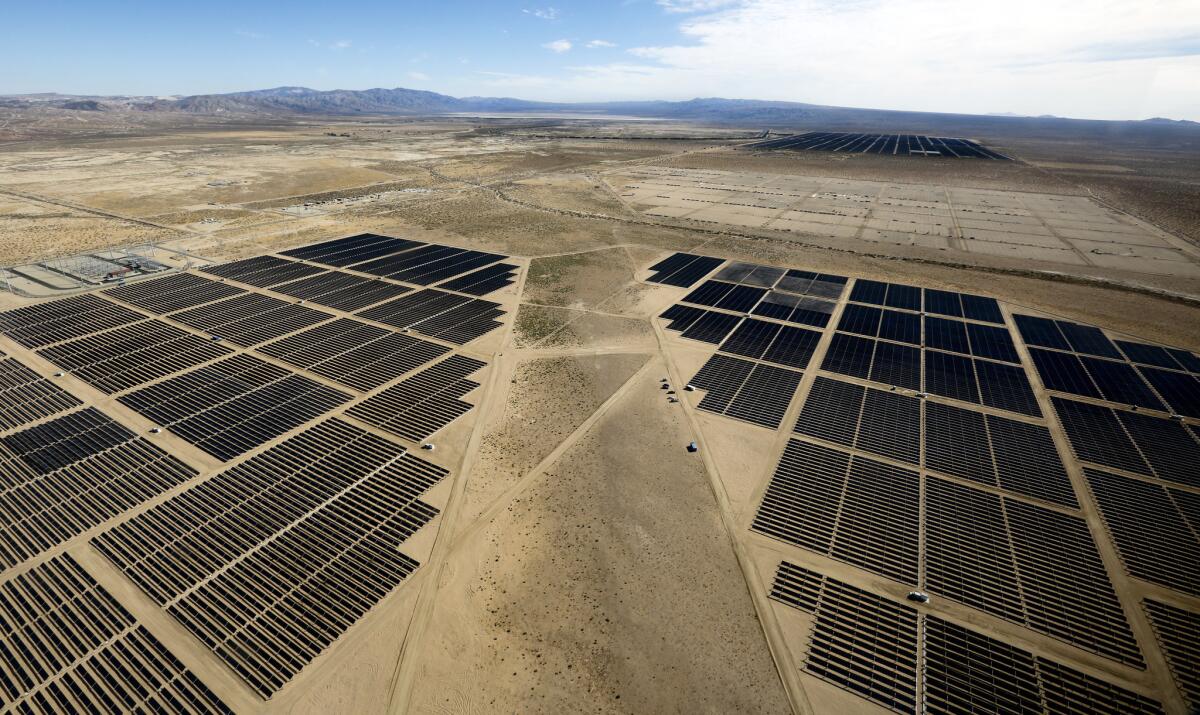The DWP is expanding its rooftop panel program to the ‘solar desert’ to meet its energy goals

- Share via
Los Angeles utility commissioners want to pay homeowners in the city’s disadvantaged communities to generate electricity from the sun.
Residential customers who participate in the city’s Solar Rooftops Program will receive a $30 credit each month or $360 a year in exchange for allowing the Los Angeles Department of Water and Power to put city-owned solar panels on their property. The unusual pilot program aims to install solar panels on 400 rooftops over the next three years, beginning in early 2017.
“We are pleased to be able to offer participation in our solar programs to customers regardless of income level so they can save money on their electric bills while also being environmentally responsible,” DWP General Manager David Wright said.
The Board of Water and Power Commissioners approved the project last week for rooftops that meet city requirements on 3-2 vote. The solar systems will range between 2 and 4 kilowatts of capacity for a total of up to 1 megawatt of new solar energy. A typical residential solar system has a capacity of 5 to 6 kilowatts, which would be enough to supply the average home’s electricity use.
The solar rooftops program is part of the DWP’s effort to reach 400 megawatts of solar power generation in 2017 as outlined by Los Angeles Mayor Eric Garcetti. The city also is working toward achieving the state-mandated goal of producing 33% of its energy from renewable sources by 2020 and 50% by 2030.
Part of the strategy is to move L.A. away from coal as a fuel source to generate electricity.
The city recently completed its Barren Ridge Renewable Transmission Project, which will bring clean energy to L.A. homes from wind and solar farms in the Tehachapi Mountains and Mojave Desert. The Barren Ridge project delivers 1,000 megawatts of solar and wind energy — enough to power 25,000 L.A. homes.
In addition, the city leads the state in rooftop solar generation with some 20,000 homes generating solar power. Environment California ranked Los Angeles No. 1 in the country for total solar capacity in 2015 with $293 million in incentives paid for solar power installations.
But low-income communities have not shared as much in the clean energy revolution as wealthier areas of the city, creating what advocates for the disadvantaged have dubbed a “solar desert.”
“The Solar Rooftops Program is another step in LADWP’s efforts to meet the goals of reaching 400 megawatts of solar power … in a way that involves more Angelenos across the entire city,” Commission Vice President William W. Funderburk Jr. said.
The high cost of solar systems, which can run from $10,000 to $20,000 without government subsidies, has made it difficult for lower-income homeowners to afford one. And leasing programs and financing through attaching the solar cost to property taxes typically require good credit scores that some homeowners with low incomes might not have.
One DWP commissioner who voted against the pilot program questioned the cost.
Interested in the stories shaping California? Sign up for the free Essential California newsletter »
“In principle, I totally support the mission,” Commissioner Christina Noonan said. “The math just isn’t working out for me.”
The electricity from photovoltaic panels installed through the Solar Rooftops Programs will flow directly into the DWP grid rather than to the individual homes that lend their roofs to the operation. The wider distribution of solar energy production around the city will help balance out the grid and improve stability, utility officials said.
The DWP’s latest pilot program joins efforts across the country to make use of rooftop space by compensating the property owner while the solar system is owned by a utility or other solar developer.
“The idea is to spread some of the benefits of solar,” said Jessica Goodheart, director of Repower LA, a part of the nonprofit organization Los Angeles Alliance for a New Economy. “A lot of people don’t have the upfront capital to invest in solar, or they may not have the credit to participate in a long-term lease. They may just want a public option.”
Goodheart’s organization reviewed data about rooftop solar installations in the city over a 15-year period and found that the majority were in affluent areas such as Bel-Air, while low-income communities such as Southeast L.A. lacked solar power.
Alicia Rivera, a community organizer for Communities for a Better Environment, which advocated for the program, said the solar program is important for areas such as Wilmington, which face significant air pollution from power plants and the ports of Los Angeles and Long Beach.
“The programs would help alleviate the pollution,” Rivera said. “That will be achieving some environmental justice.”
The $12.9-million project, which is subject to L.A. City Council approval, includes 20-year lease payments as well as construction, administrative, operation and maintenance costs. To qualify, homes must be owner occupied, meet all DWP and Los Angeles Department of Building and Safety requirements and have suitable rooftops.
There is no upfront cost to customers or credit checks. And the DWP will be responsible for the operation and maintenance of the solar panels.
Although the program focuses on areas of low solar penetration, those selected for the program will not have to prove a particular income level.
“People don’t have get their tax returns out,” Goodheart said. “It will be income-targeted as opposed to income-qualified.”
The city expects to launch a companion program in 2018 that will provide apartment residents with access to solar power. The project, called Shared Solar, will also operate as a pilot project, allowing renters to tap solar for a one-year trial period.
“We seeing this as beginning to create more equity,” Goodheart said.
For more energy news, follow Ivan Penn on Twitter: @ivanlpenn
MORE LOCAL NEWS
A mosquito bite, then paralysis: How the West Nile Virus turned this teacher’s life upside down
Appeals court affirms judge’s decision to toss DA off mass-shooter case
Family sues San Diego police department, city and officer who killed their dog
More to Read
Inside the business of entertainment
The Wide Shot brings you news, analysis and insights on everything from streaming wars to production — and what it all means for the future.
You may occasionally receive promotional content from the Los Angeles Times.










